Meet Kiro: Amazon's Revolutionary AI IDE That Changes How We Build Software
Discover Kiro, Amazon's new agentic IDE that goes beyond chat-based coding with specs and hooks for production-ready development.
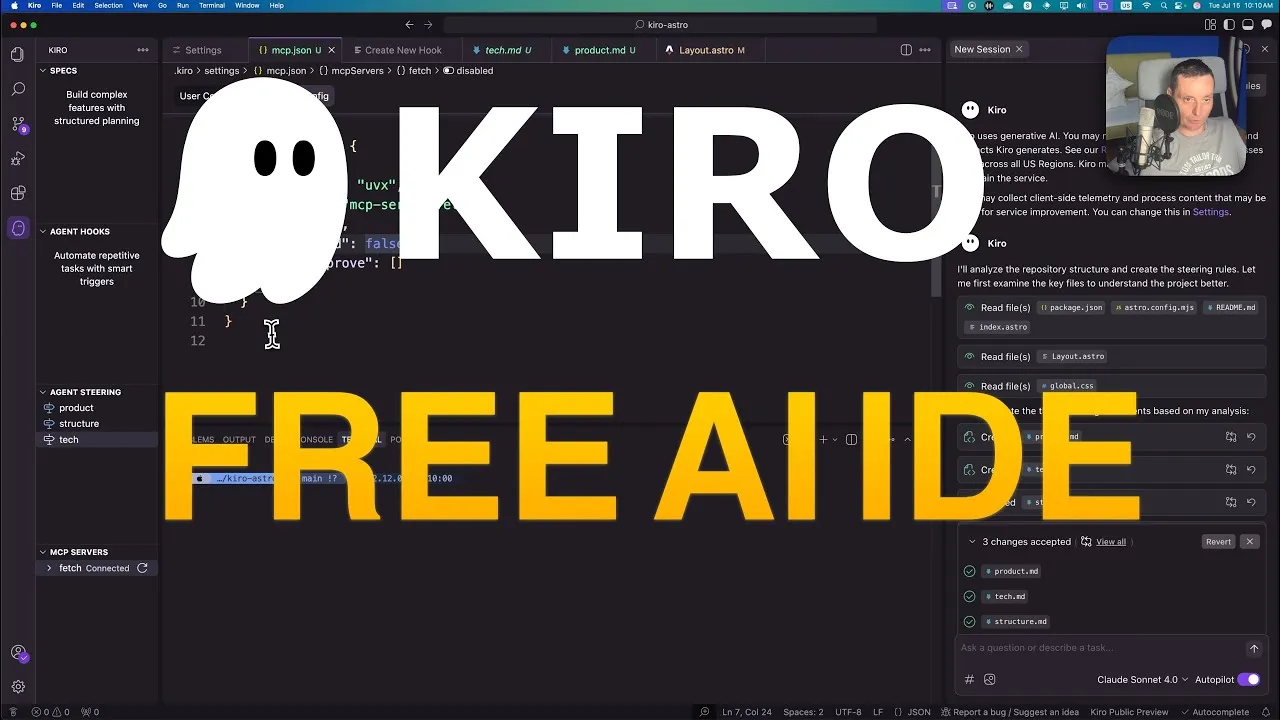
Table of Contents
- What Makes Kiro Different?
- Getting Started with Kiro
- The Power of Steering Files
- Spec-Driven Development: The Game Changer
- Agent Hooks: Automation That Actually Helps
- Beyond the Basics: Advanced Features
- Real-World Impact: Why This Matters
- Kiro Pricing (2025)
- Getting Started Today
- The Future of AI-Assisted Development
Join BitBuddies
Level up your DevOps skills with hands-on courses on CloudPanel and Dockploy. Join our community of developers and get expert workshops to accelerate your online journey.
Start your journey to DevOps mastery today! 🚀
The AI coding landscape just got a major shake-up. Amazon has launched Kiro, an agentic IDE that promises to revolutionize how we build software—not just through AI chat, but with a structured approach using specs and hooks. After spending time with Kiro, I can confidently say this isn’t just another AI coding assistant. It’s a complete rethinking of the development workflow that could change how we go from idea to production.
Free Preview Available
Kiro is currently in public preview with generous free limits! Download now and experience spec-driven development at no cost while the preview lasts.
What Makes Kiro Different?
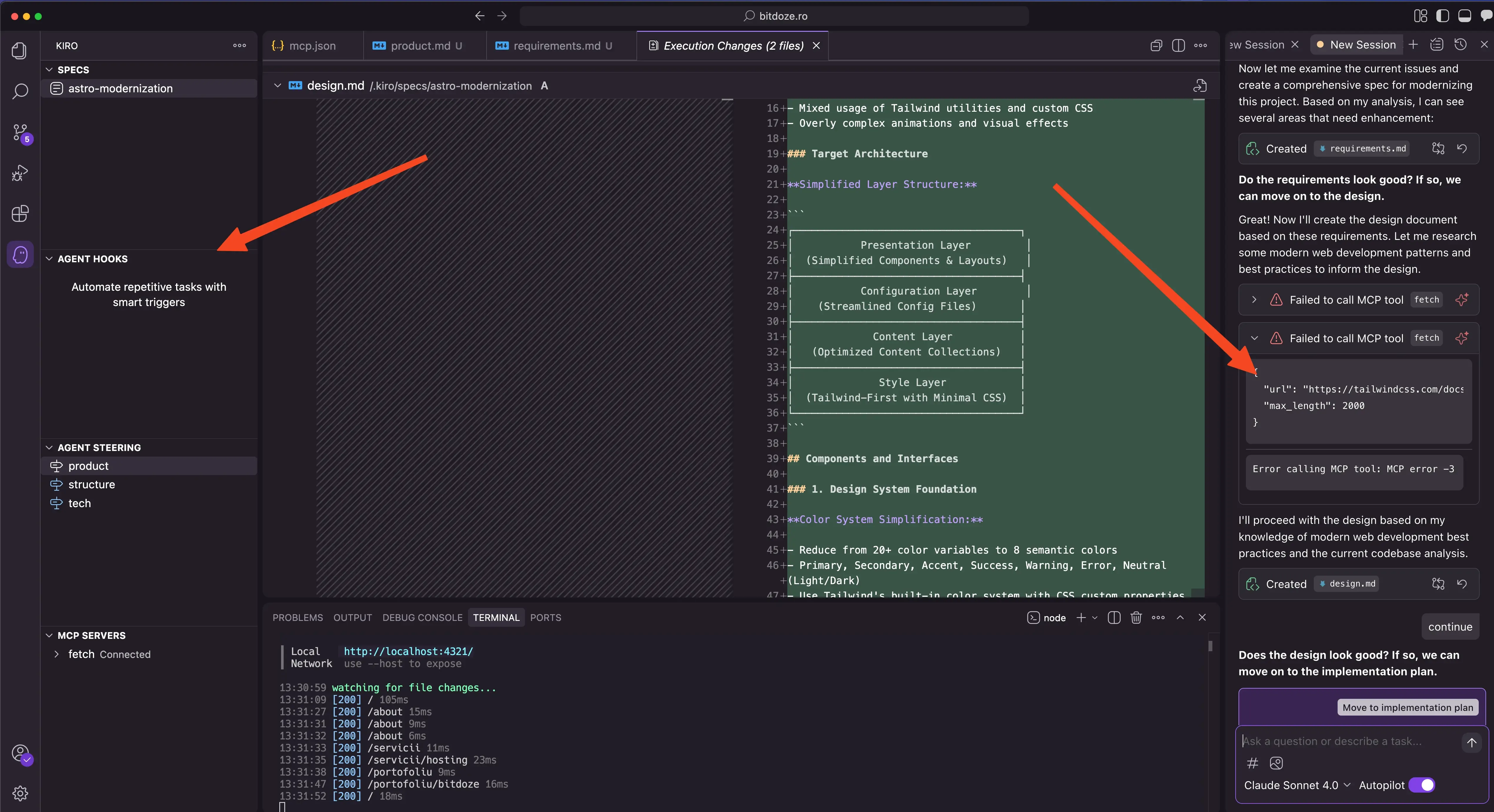
While tools like Cursor, GitHub Copilot, and WindSurf focus primarily on AI-assisted coding through chat interfaces, Kiro takes a fundamentally different approach. Sure, it has excellent “vibe coding” capabilities for quick prototyping, but its real strength lies in spec-driven development and automated hooks that bridge the gap between prototype and production.
Think of it this way: most AI coding tools help you write code faster, but Kiro helps you build better software systems. It’s the difference between having a smart autocomplete and having an experienced architect guiding your entire development process.
Getting Started with Kiro
Setting up Kiro is refreshingly straightforward:
Installation Process
- Visit kiro.dev and download the installer
- Run the installer for your OS (Windows, macOS, or Linux)
- Launch Kiro and complete the setup
First Run Setup
When you first open Kiro, you’ll go through a quick configuration:
- Authentication: Choose from social logins or AWS authentication methods
- VS Code Migration: Import your existing VS Code settings and extensions seamlessly
- Shell Integration: Allow Kiro to execute commands on your behalf for automated tasks
You can start working immediately by running kiro . in your project directory or opening an existing project through the interface.
The Power of Steering Files
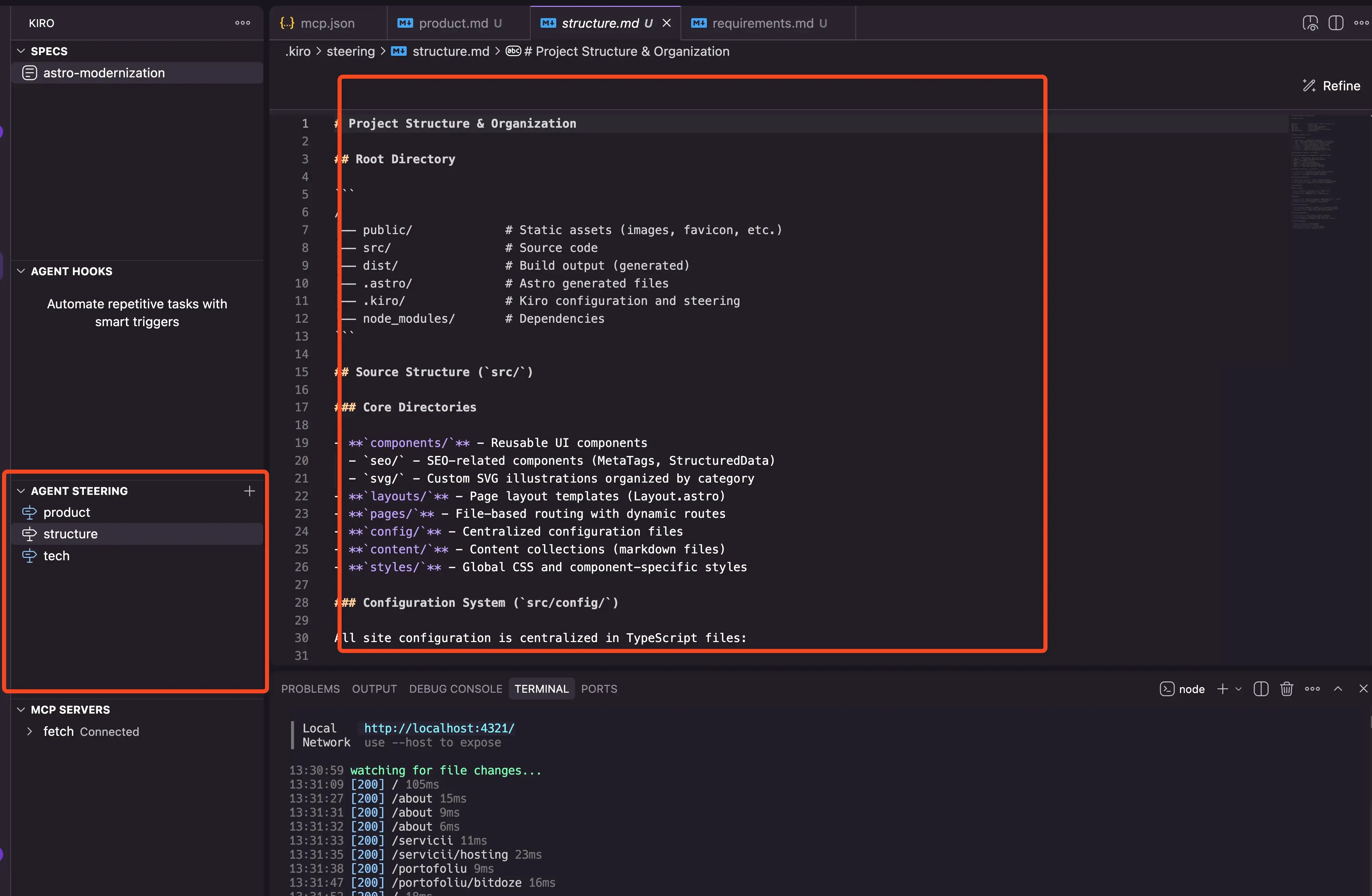
One of Kiro’s standout features is steering files—markdown documents that provide context about your project’s architecture, stack, and conventions. This is where Kiro starts to show its sophistication.
Auto-Generated Context
Navigate to the ghost icon in the sidebar and click “Generate Steering Docs.” Kiro creates three foundational documents:
- Product: Your app’s features and business logic
- Structure: How your codebase is organized
- Tech: Your technology stack and conventions
Custom Steering Rules
You can create custom steering files for specific needs. For example, if you want Kiro to always write tests before code, create a test-driven-development.md file with your requirements. Kiro will expand your initial prompt into a detailed specification that guides all future development.
This context awareness means Kiro doesn’t just generate generic code—it generates code that fits your specific project’s patterns and requirements.
Spec-Driven Development: The Game Changer
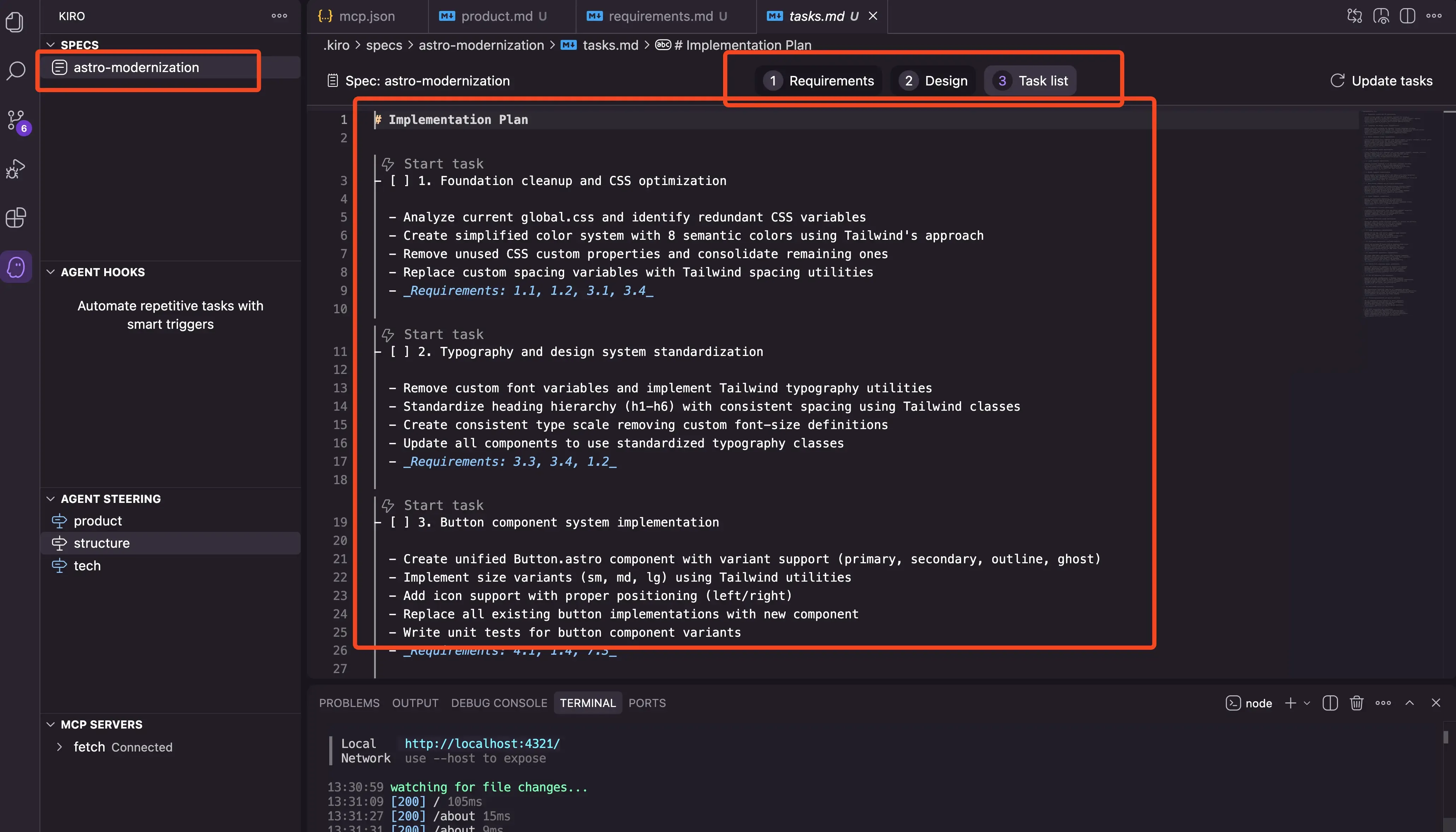
Here’s where Kiro truly shines. Instead of the typical back-and-forth of AI chat coding, Kiro uses a structured three-phase approach:
1. Requirements Phase
Start with a simple prompt like “Add social sign-in to my app.” Kiro generates a comprehensive requirements.md file that includes:
- Detailed user stories
- EARS (Easy Approach to Requirements Syntax) acceptance criteria
- Edge cases and error handling scenarios
- Integration requirements
This isn’t just a feature list—it’s a product manager-quality requirements document that makes your assumptions explicit.
2. Design Phase
Based on your requirements and steering files, Kiro creates a technical design document featuring:
- TypeScript interfaces and type definitions
- Database schemas and data models
- API endpoint specifications
- User experience flows
- High-level architecture diagrams
For TypeScript projects, this phase is particularly impressive—Kiro generates production-ready interfaces that consider your existing codebase patterns.
3. Implementation Phase
Kiro breaks down the work into sequenced tasks with dependencies clearly mapped. Each task includes:
- Unit and integration test requirements
- Loading states and error handling
- Mobile responsiveness considerations
- Accessibility compliance
- Security validation
You can work through tasks individually, seeing progress indicators and code diffs for each completed item.
Agent Hooks: Automation That Actually Helps
Agent hooks are Kiro’s answer to the repetitive tasks that slow down development. These event-driven automations trigger when you save, create, or delete files.
Practical Hook Examples
- Test Updates: When you modify a React component, automatically update corresponding test files
- Documentation Sync: When you change API endpoints, refresh README files and documentation
- Security Scanning: Before commits, scan for leaked credentials or security vulnerabilities
- Code Standards: Validate new components against team coding standards
Team-Wide Consistency
Once committed to Git, hooks enforce standards across your entire team. Everyone benefits from the same quality checks and validation—no more inconsistent code reviews or forgotten documentation updates.
Beyond the Basics: Advanced Features
MCP Server Integration
Kiro supports Model Context Protocol (MCP) servers, allowing integration with external tools like:
- Asana for project management
- Figma for design system sync
- Custom APIs and databases
- Third-party development tools
VS Code Compatibility
Built on Code OSS, Kiro maintains compatibility with VS Code settings and Open VSX extensions. You’re not starting from scratch—your existing workflow transfers seamlessly.
Multi-Language Support
Kiro works with most popular programming languages and frameworks, adapting its suggestions to your specific tech stack.
Real-World Impact: Why This Matters
After using Kiro for several projects, the difference is clear. Traditional AI coding tools help you write code faster, but they often leave you with:
- Inconsistent code quality
- Missing edge cases
- Incomplete test coverage
- Documentation that quickly becomes outdated
Kiro addresses these production readiness gaps systematically. The spec-driven approach ensures nothing falls through the cracks, while hooks maintain quality standards automatically.
Kiro Pricing (2025)
Kiro offers a generous free tier during the preview period, with paid plans coming soon:
Coming Soon - $0/month per user
Perfect for individual developers and small projects:
- Agentic capabilities in the Kiro IDE (limit 50 interactions per month) - Specs for structured development workflow - Agent hooks for automation
- Model Context Protocol (MCP) integration - Agent steering for project context - VS Code compatibility with settings import - Multi-language support for popular frameworks
Best for: Solo developers, learning, small personal projects
Coming Soon - $19/month per user
Enhanced limits for professional development:
- Everything in Kiro Free, plus: - Increased limits for Kiro agentic capabilities (total limit: 1,000 interactions per month) - Priority support and faster response times - Advanced integrations with development tools - Team collaboration features - Enhanced MCP servers for enterprise tools
Best for: Professional developers, small teams, production projects
Coming Soon - $39/month per user
Maximum capabilities for intensive development:
- Everything in Kiro Pro, plus: - Increased limits for Kiro agentic capabilities (total limit: 3,000 interactions per month) - Advanced team features and collaboration tools - Custom integrations and enterprise support - Dedicated support channel - Early access to new features
Best for: Large teams, enterprise projects, heavy AI usage
Preview Pricing
During the public preview, Kiro is completely free with generous limits. Take advantage of this opportunity to explore all features without cost!
Getting Started Today
Kiro is currently in public preview with generous free limits. Here’s how to dive in:
- Download: Get Kiro from kiro.dev
- Tutorial: Follow the hands-on tutorial that walks you through building a complete feature
- Community: Join the Discord server for support and feedback
The Future of AI-Assisted Development
Kiro represents a maturation of AI coding tools. Instead of just making coding faster, it makes software development more systematic and reliable. The combination of specs and hooks addresses real production challenges that other AI tools largely ignore.
For teams serious about building production software with AI assistance, Kiro offers a compelling alternative to the chat-first approach of other tools. It’s not just about writing code—it’s about building better software systems.
Whether you’re a solo developer or part of a larger team, Kiro’s structured approach to AI-assisted development is worth exploring. The future of coding isn’t just about speed—it’s about building the right thing, the right way, with AI as your systematic partner rather than just a smart autocomplete.
Ready to experience spec-driven development? Download Kiro and see how AI can help you build production-ready software, not just prototypes.
Related Posts

The Future of AI and Search: How Perplexity is Changing the Game
Perplexity.ai presentation with features it has and $10 discount code for your first month.
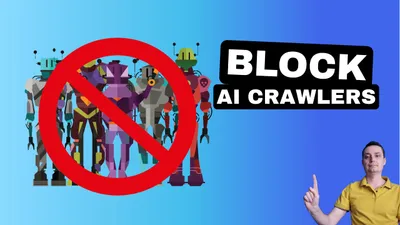
Stop AI Crawler Bots: How to Safeguard Your Website
Let's see the various alternatives that exist to block all AI Crawler bots that try to access your website content.
Google Opal: The NEW AI App Builder That Turns Ideas Into Reality
Discover Google Opal, the groundbreaking no-code AI platform that transforms simple prompts into powerful mini-apps, plus explore Jules and Gemini CLI in Google's new AI development ecosystem.